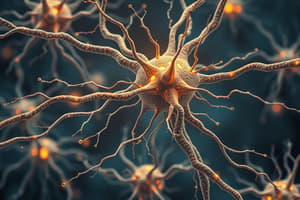Podcast
Questions and Answers
¿Cuál es la función principal de las dendritas en una neurona?
¿Cuál es la función principal de las dendritas en una neurona?
- Liberar neurotransmisores en la hendidura sináptica
- Producir proteínas para mantener la funcionalidad de la neurona
- Recibir y transmitir mensajes entrantes desde otras neuronas (correct)
- Enviar mensajes a otras neuronas
¿Qué parte de la neurona envía mensajes salientes a otras neuronas?
¿Qué parte de la neurona envía mensajes salientes a otras neuronas?
- Axón (correct)
- Dendritas
- Cuerpo celular
- Núcleo
¿Qué desencadena un potencial de acción en una neurona?
¿Qué desencadena un potencial de acción en una neurona?
- Un impulso eléctrico cuando la entrada supera un umbral determinado (correct)
- La producción de proteínas
- Electricidad estática
- La liberación de neurotransmisores
¿Cuál es la función principal de un neurotransmisor en una sinapsis?
¿Cuál es la función principal de un neurotransmisor en una sinapsis?
¿Qué característica permite a las neuronas formar circuitos complejos para procesar información?
¿Qué característica permite a las neuronas formar circuitos complejos para procesar información?
¿Qué función desempeñan las neuronas sensoriales?
¿Qué función desempeñan las neuronas sensoriales?
¿Cuál es el papel de los neurotransmisores en el procesamiento neuronal?
¿Cuál es el papel de los neurotransmisores en el procesamiento neuronal?
¿Qué categoría de neuronas se encarga de controlar funciones autónomas como la frecuencia cardíaca?
¿Qué categoría de neuronas se encarga de controlar funciones autónomas como la frecuencia cardíaca?
¿Cuál es uno de los efectos fisiológicos regulados por neurotransmisores como la serotonina?
¿Cuál es uno de los efectos fisiológicos regulados por neurotransmisores como la serotonina?
¿Qué tipo de neuronas actúan como eslabones intermedios entre regiones sensoriales y motoras o entre niveles superiores de procesamiento?
¿Qué tipo de neuronas actúan como eslabones intermedios entre regiones sensoriales y motoras o entre niveles superiores de procesamiento?
Flashcards are hidden until you start studying
Study Notes
Neurons
Neurons, also known as nerve cells, are specialized cells responsible for transmitting information throughout the body via electrical and chemical signals. They form the foundation of the nervous system, which includes the brain, spinal cord, and peripheral nerves. Understanding neurons is crucial because they play a vital role in how we sense, think, move, and interact with our environment. This article will explore the structure of neurons, their functions, neurotransmitters, types, and neural networks.
Structure of Neurons
Neurons have three main parts: the cell body, dendrites, and axon. The cell body contains the nucleus and various organelles necessary for the production of proteins required for maintaining the neuron's functionality. Dendrites are short branched fibers that receive and transmit incoming messages from other neurons, while the axon sends outgoing messages to other neurons. An average human brain has approximately 86 billion neurons, each connected by synapses, forming complex circuits that allow us to process information.
Function of Neurons
The primary function of neurons is communication within the nervous system. When a signal arrives at a neuron through its dendrites, it triggers an electrical pulse called an action potential if the input exceeds a certain threshold. This action potential travels down the axon to the endings where it can release neurotransmitter molecules into the synaptic cleft. These chemical messengers bind to receptors on the receiving cell's dendrites, modifying their activity in some manner, thus facilitating further processing, transmission, or termination of the message.
Neurotransmitters
Neurotransmitters are chemicals released by neurons that interact with specific proteins found on the surface of the target cell, either another neuron or a muscle cell. There are over 100 different neurotransmitters identified, including dopamine, norepinephrine, serotonin, glutamate, GABA, acetylcholine, histamine, and many others. Each type of neurotransmitter plays a distinct role in neuronal signaling pathways that regulate various physiological processes such as mood, cognition, pain perception, sleep cycles, and more.
Types of Neurons
There are several categories of neurons based on their morphology and function. Some common types include sensory neurons, motor neurons, relay neurons, interneurons, and ganglion cells. Sensory neurons detect stimuli like touch, temperature, and light, converting these physical changes into an electrical response that can be transmitted to the central nervous system. Motor neurons convey signals from the brain and spinal cord to muscles and glands, controlling movement and secretion. Relay neurons act as intermediate links between sensory and motor regions or between higher levels of processing. Interneurons connect different regions of the CNS, allowing for intricate communication within the brain and spinal cord. Ganglion cells are large, specialized neurons located outside the brain and spinal cord that control autonomic functions like heart rate and digestive processes.
Neural Networks
Neural networks refer to complex webs of interconnected neurons that work together to perform specific computational tasks. In biology, this concept is represented by the intricate connections among individual neurons in our nervous system. These neural networks enable efficient data processing, pattern recognition, and decision-making. By studying artificial neural networks inspired by biological ones, researchers hope to gain insights into both the underlying principles governing neural computation and develop advanced algorithms for various applications, ranging from image recognition to natural language processing.
Studying That Suits You
Use AI to generate personalized quizzes and flashcards to suit your learning preferences.




